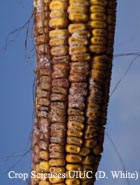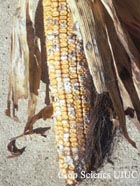Gibberella or Red Ear Rot


Symptoms
- Reddish mold appears first at the ear tip and spreads downward
- The ear most often be only partially covered with the reddish mycelium
- Early infection may cause the entire ear to be colonized with mycelium and partially rotted, which may cause the ear to be glued to the husk
- Tiny black fruiting structures may be found on the husks and ear shanks.
Pathogen Involved
- Gibberella zeae (=Fusarium graminearum) (a fungus)
- This pathogen produces multiple mycotoxins that are harmful to humans as well as animals.
- Overwinters in corn residue
- The same pathogen causes head scab (blight) of wheat
Time of Occurrence
- Infection takes place within the silks or at the base of the ear when heavy rainfall occurs late in the season
- This disease occurs after silking
Conditions Favoring Disease
- Cool and wet conditions soon after silking
- Corn on corn rotation, or a wheat and corn rotation
- Wheat or corn residue on soil surface
- Damaged kernels
Disease Management
- Corn hybrids differ in susceptibility, but resistant hybrids not reported
- Corn hybrid with tight husks may be more susceptible.
- Crop rotation
- Fall tillage may be helpful where appropriate